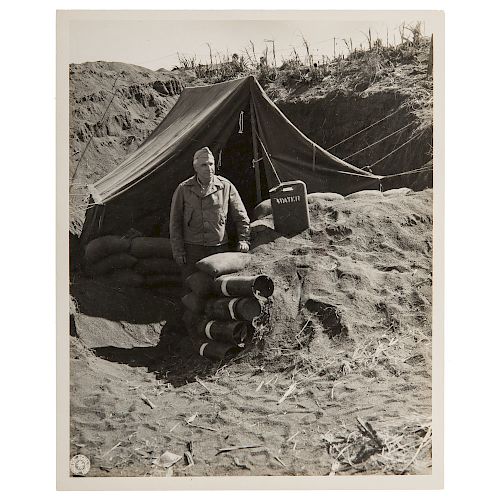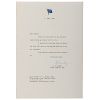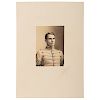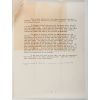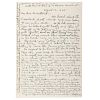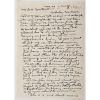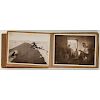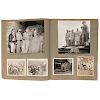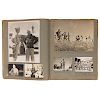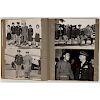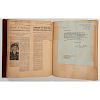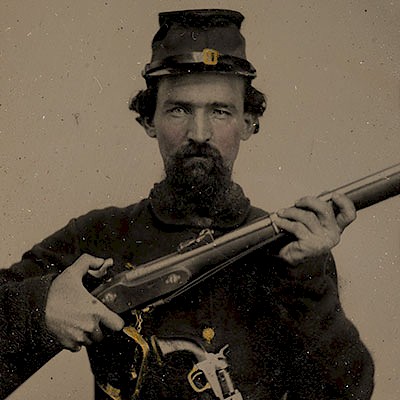Major General James E. Chaney Archive, Incl. Letters from Iwo Jima
About Seller
6270 Este Ave.
Cincinnati , OH 45232
United States
With offices in Cincinnati, Cleveland and Denver, Cowan’s holds over 40 auctions each year, with annual sales exceeding $16M. We reach buyers around the globe, and take pride in our reputation for integrity, customer service and great results. A full-service house, Cowan’s Auctions specializes in Am...Read more
Two ways to bid:
- Leave a max absentee bid and the platform will bid on your behalf up to your maximum bid during the live auction.
- Bid live during the auction and your bids will be submitted real-time to the auctioneer.
Bid Increments
| Price | Bid Increment |
|---|---|
| $0 | $25 |
| $500 | $50 |
| $1,000 | $100 |
| $2,000 | $250 |
| $5,000 | $500 |
| $10,000 | $1,000 |
| $20,000 | $2,500 |
| $50,000 | $5,000 |
| $100,000 | $10,000 |
About Auction
Jun 21, 2019
On June 21, Cowan’s Auctions will be offering a remarkable selection of historic photography, letters, documents, flags, political ephemera, and more representing the Revolutionary War-period through the Civil War, Indian Wars, and beyond, as well as the American West. Cowan's Auctions dawnie@cowans.com
- Lot Description
Large archive related to the career of Major General James E. Chaney (1885-1967) featuring personal correspondence, ten scrapbooks/photo albums, and other memorabilia. Lot is highlighted by an impressive grouping of 180+ letters written by the general to his wife, Miriam Clark Chaney. The letters, dated November 17, 1944 - August 30, 1945, were written while Chaney served as the Commanding General of the Army Garrison Force at Iwo Jima, where he planned and executed the seizure and occupation of the island, and then served as commander of all US Forces on Iwo Jima.
James Eugene Chaney was born in Maryland to Dr. and Mrs. Thomas Chaney. He graduated from West Point in 1908 and embarked upon a decades-long military career. In 1910 Chaney married Miriam Clark (1884-1967), the daughter of Colonel Charles Hobart Clark and granddaughter of General Rene Edward De Russy. After WWI Chaney was sent to Rome as air attache at the American Embassy where he remained for five years, and he later graduated from the Air Service Tactical School at Langley Field. Chaney was a prominent figure in the emerging aerial warfare service in the years leading up to WWII, serving in numerous roles including as commandant of the Advanced Flying School at Kelly Field, commanding Randolph Field training school, and as head of the Air Defence Command at Mitchel Field.
With the outbreak of WWII, Chaney was assigned to the United Kingdom serving as Head of the Special Army Observers Group and from January to June 1942 as theater commander in Europe before the appointment of Major General Dwight D. Eisenhower to the role. In 1942 Chaney was appointed as commanding general of the First Air Force, then in 1944 Chaney was given command of the Army forces at Iwo Jima. He served in several other roles as WWII drew to a close before retiring from military life in 1947. A highly decorated veteran, he was awarded the Distinguished Service Medal in 1943 and was awarded the Legion of Merit for "the defense and development of one of the most vital bases in the Pacific for the continuance of air assaults and naval operations against the Japanese homeland."
Writing to his wife almost daily starting in November 1944, Chaney is initially limited in what he can convey. His letters are warm, affectionate, and relate only general details of his location and activities. He sometimes includes anecdotes about soldiers and his thoughts on developments of the war in Europe. It is notable that in February 1945 as the Battle of Iwo Jima (February 19 - March 26, 1945) is about to commence, Major General Chaney writes with less frequency, and the letters he does write are noticeably shorter. Gradually, he resumes writing lengthier letters. He tells his wife on March 12, 1945, as the Battle of Iwo Jima rages on, that he "Cannot say where I am except in the Western Pacific. Very heavy fighting is and has been going on here for about three weeks now. The Japs have been using everything - day and night, rocket and mortars of various sizes, artillery, bombing and suicide attacks (both in water and shore) machine guns, land mines, snipers, booby traps, etc...I arrived off the shore of this place early in the dawn, about two hours before our attack started. Came in with the assault echelon. We have gotten all the airfields now and things are going very well.... There is nothing left here in the way of shelter - all shot away...." The letters written after the invasion of Iwo Jima are somewhat less restrained, and often contain private observations about the Pacific battlefront. Writing on April 13, 1945, Chaney writes about the "shock" of learning about the President's death and about the capture of Japanese soldiers. " We are still killing and capturing a lot each day. The prisoners, one or two, go out with our patrols to places where numbers are hiding out and advise them to give up. Sometimes large groups give up including quite a number of officers. It is certainly interesting to see them especially when they first are brought in - They all expect to be tortured and shot. They certainly have given us a lot of useful information." Chaney's later letters also include multiple references to American B-29s bombing Tokyo and to events leading up to the Japanese surrender.
In addition to Chaney's letters to his wife, multiple documents of interest are in the archive. Notable are Chaney's typed personal notes on meeting Stalin in 1941, his impressions of Mussolini, and his private thoughts on a 1942 trip to Northern Ireland. The archive contains two ALsS from Chester W. Nimitz, signed "C. W. Nimitz" while serving as Fleet Admiral, USN; letters signed by Lady Nancy Astor, WWI flying ace Eddie Rickenbacker, and Louis Mountbatten; and a typed transcript of Major General Chaney's April 1945 Army Day Broadcast from Mt. Suribachi which is referenced in his letters to his wife. An autographed photo signed "Joe Louis" shows the famous boxer with Chaney.
Photographs in the collection number in the hundreds, with sizes ranging from 2.5 x 1.75 in. to 8 x 10 in., most undated but the bulk ranging from WWI through 1945. Some photos are loose, but most are affixed in scrapbooks and photo albums. Albums trace Chaney's life from West Point through to his later military assignments, and document a variety of subjects such as General and Mrs. Chaney's ca 1920 overseas travels to Tunisia, Italy, Libya, Greece, France and other countries; images of World War I carnage; family photographs; formal portraits of General Chaney at various stages in his career; and a large number of images from General Chaney's various military posts including at Iwo Jima. Many images in the albums are hand labeled on top of image or below. Often images that are not contained in albums indicate that they originated from military sources such as the US Army Signal Corps or US AAF Training Command.
Additional items of note in the collection include an arming wire pulled from a bomb released by a B-29 over Toyko on May 26, 1945, and referenced in Chaney's correspondence; calling cards and social invitations from various diplomats, dignitaries, and politicians including the President and Mrs. Roosevelt; newspaper clippings documenting decades of Chaney's military career; and additional letters written to Chaney from family, friends, and military associates.
The archive descends to the consignor via Major General James E. Chaney's niece on his wife's side.Most photos are permanently affixed to albums. Generally all items are in good condition given age. Letters from Chaney to his wife are all in good condition and easily legible.Condition
- Shipping Info
-
Buyers are required to pay for all packing, shipping and insurance charges. Overseas duty charges are the responsibility of the successful Bidder. Be aware that for larger and/or valuable items, shipping charges can be substantial. - If there is no shipping amount on listed your invoice, you will need to make arrangements to pick up or ship your purchase through an alternative shipping company. Our shipping department can be contacted at 513.871.1670 (ext. 219) or email shipping@cowans.com. - Shipping charges include insurance for your order while in transit. If you have private insurance we will adjust your charge to include only packing and shipping. - Please allow 14 – 21 days after payment to package and ship your purchase as carefully as possible.
-
- Buyer's Premium



 EUR
EUR CAD
CAD AUD
AUD GBP
GBP MXN
MXN HKD
HKD CNY
CNY MYR
MYR SEK
SEK SGD
SGD CHF
CHF THB
THB